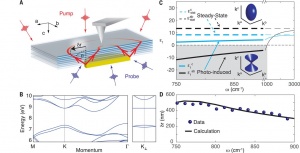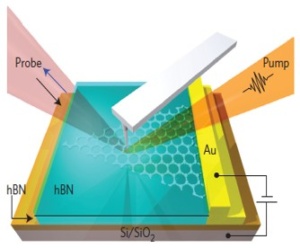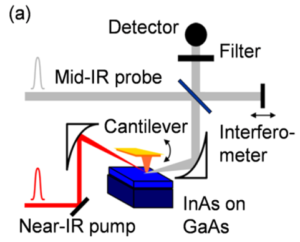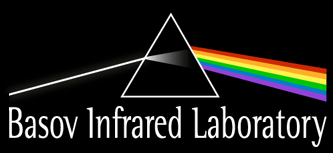Optical Control of Quantum Phases
Exposing solids to sub-picosecond (ps) electromagnetic pulses with electric field strengths as high as 1 V/Å can cause large transient changes to the electronic and structural degrees of freedom, leading to the modification of the equilibrium electronic phase – enhancing or suppressing electronic orders including superconductivity, orbital order, magnetism, and topological order. The transient state can form completely new electronic phases – “hidden” phases not observed at equilibrium. Light-induced transformations typically impact nano-scale regions, leading to a spatially non-uniform and non-equilibrium state of matter. Therefore, the optical excitation, together with the optical interrogation of transient properties, must be carried out locally. In our group we devised and deployed instrumentation needed to carry out nano-scale and time-resolved pump-probe studies.
Programmable Hyperbolic Polaritons in Van der Waals Semiconductors
Sternbach et al. Science 371, 6529 (2021) Ref. [293]
Read More
 Collective electronic modes or lattice vibrations usually prohibit propagation of electromagnetic radiation through the bulk of common materials over a frequency range associated with these oscillations. Though in layered crystals highly anisotropic materials often display nonintuitive optical properties and can permit propagation of subdiffractional waveguide modes, with hyperbolic dispersion, throughout their bulk. Here, we report on the observation of optically induced electronic hyperbolicity in the layered transition metal dichalcogenide tungsten diselenide (WSe2). By using photoexcitation to inject electron-hole pairs in WSe2 , we were able to visualize the hyperbolic rays that traveled along conical trajectories inside of the crystal, thus establishing here the signatures of programmable hyperbolic electrodynamics and assessing the role of quantum transitions of excitons within the Rydberg series in the observed polaritonic response.
Collective electronic modes or lattice vibrations usually prohibit propagation of electromagnetic radiation through the bulk of common materials over a frequency range associated with these oscillations. Though in layered crystals highly anisotropic materials often display nonintuitive optical properties and can permit propagation of subdiffractional waveguide modes, with hyperbolic dispersion, throughout their bulk. Here, we report on the observation of optically induced electronic hyperbolicity in the layered transition metal dichalcogenide tungsten diselenide (WSe2). By using photoexcitation to inject electron-hole pairs in WSe2 , we were able to visualize the hyperbolic rays that traveled along conical trajectories inside of the crystal, thus establishing here the signatures of programmable hyperbolic electrodynamics and assessing the role of quantum transitions of excitons within the Rydberg series in the observed polaritonic response.
Ultrafast Optical Switching of Infrared Plasmon Polaritons in High-Mobility Graphene
Ni et al. Nature Photonics 10, 244 (2016) Ref. [225]
Read More
 Graphene is emerging as one of the most capable candidates for plasmonic media for infrared wavelengths. Here we visualize and elucidate the properties of non-equilibrium photo-induced plasmons in a high-mobility graphene monolayer4.We activate plasmons with femtosecond optical pulses in a specimen of graphene that otherwise lacks infrared plasmonic response at equilibrium. In combination with static nano-imaging results on plasmon propagation, our infrared pump–probe nano-spectroscopy investigation reveals new aspects of carrier relaxation in heterostructures based on high-purity graphene.
Graphene is emerging as one of the most capable candidates for plasmonic media for infrared wavelengths. Here we visualize and elucidate the properties of non-equilibrium photo-induced plasmons in a high-mobility graphene monolayer4.We activate plasmons with femtosecond optical pulses in a specimen of graphene that otherwise lacks infrared plasmonic response at equilibrium. In combination with static nano-imaging results on plasmon propagation, our infrared pump–probe nano-spectroscopy investigation reveals new aspects of carrier relaxation in heterostructures based on high-purity graphene.
Cooperative Photoinduced Metastable Phase Control in Strained Manganite Films
(with R.A. Averitt) Zhang et al. Nature Materials 15, 956 (2016) Ref. [229]
Read More
 We report on time-resolved mid-infrared (mid-IR) near field spectroscopy of the narrow bandgap semiconductor InAs. The dominant effect we observed pertains to the dynamics of photoexcited carriers and associated surface plasmons. A novel combination of pump− probe techniques and near-field nanospectroscopy accesses high momentum plasmons and demonstrates efficient, subpicosecond photomodulation of the surface plasmon dispersion with subsequent tens of picoseconds decay under ambient conditions. The photoinduced change of the probe intensity due to plasmons in InAs is found to exceed that of other mid-IR or near-IR media by 1− 2 orders of magnitude.
We report on time-resolved mid-infrared (mid-IR) near field spectroscopy of the narrow bandgap semiconductor InAs. The dominant effect we observed pertains to the dynamics of photoexcited carriers and associated surface plasmons. A novel combination of pump− probe techniques and near-field nanospectroscopy accesses high momentum plasmons and demonstrates efficient, subpicosecond photomodulation of the surface plasmon dispersion with subsequent tens of picoseconds decay under ambient conditions. The photoinduced change of the probe intensity due to plasmons in InAs is found to exceed that of other mid-IR or near-IR media by 1− 2 orders of magnitude.

